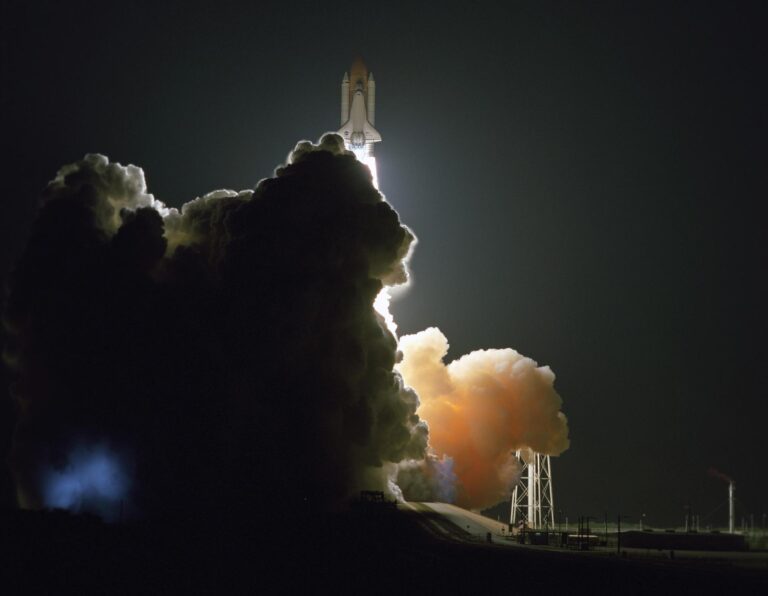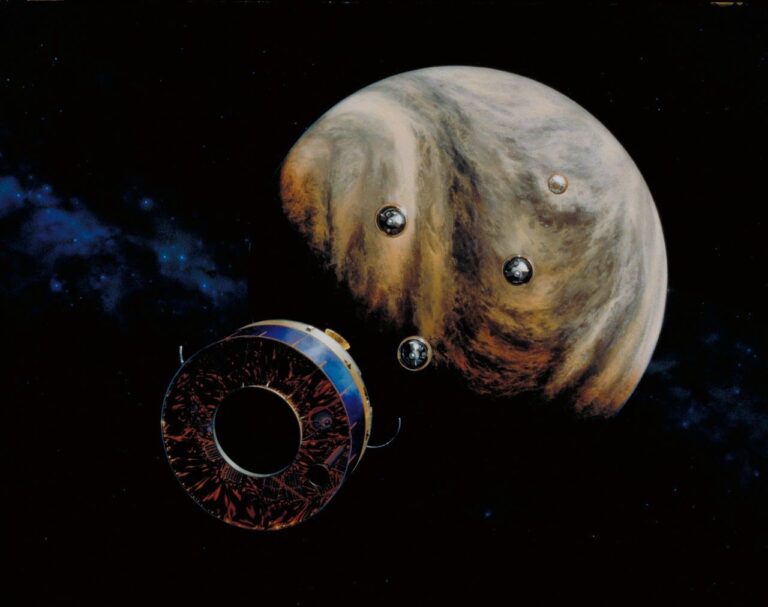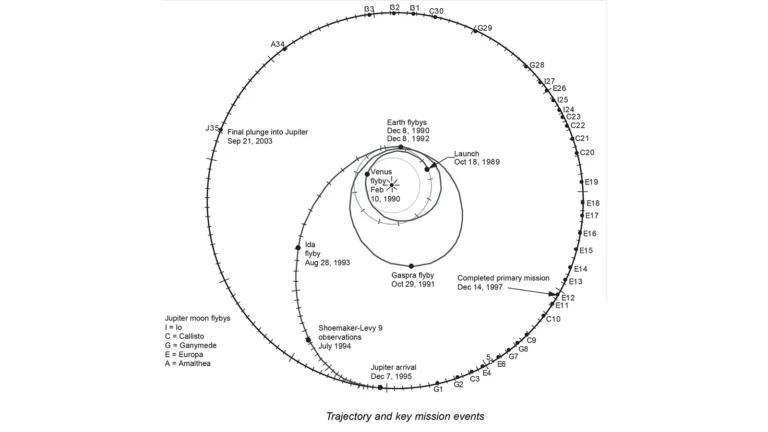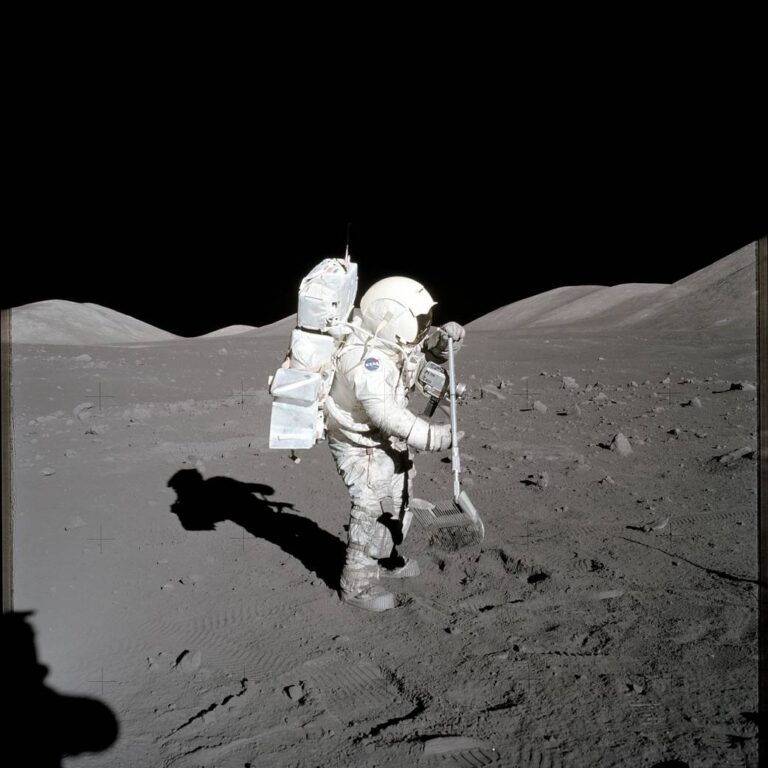Key Takeaways:
The first dives to the dark and deep places of our planet revealed a moonscape. Beneath icy waters and far from the Sun’s nourishing light, the planet appeared dead. No plants. No photosynthesis. No photons.
But then scientists in submarines began exploring Earth’s single greatest mountain range, the Mid-Oceanic Ridge, which occupies almost a quarter of our world’s surface. Explorers like Robert Ballard call this great rift the Boundary of Creation. Here, our planet bleeds molten blood through some 10,000 active volcanoes and then cools to heal itself.
In the mid-1970s, Ballard was among the first to see this other Earth. (In ’85 he discovered Titanic.) Along the Galapagos Rift, his team came across great white chimneys rising more than a dozen stories. Instead of a desert, they found thriving ecosystems in temperatures that would melt lead. No sunlight could reach such depths. But alien creatures abound in this abyss anyway. Great tube worms towered 10 feet tall alongside clams colonized by symbiotic bacteria.
And in decades of expeditions all over Earth, scientists continue to turn up new forms of life that can replicate photosynthesis using only chemicals. Their energy source, their evolutionary origins — even their food chain is distinct from ours.
These so-called extremophiles kindle hope that alien life is abundant and, just maybe, nearby. Liquid oceans have been found on Saturn’s moons Titan, Enceladus, and possibly Mimas, as well as Jupiter’s moons Europa, Ganymede, and Callisto. And scientists are investigating possible oceans on the dwarf worlds Pluto and Ceres.
But out of all these water worlds, Europa is still the most enticing. It packs more saltwater than Earth and shows signs of geologic activity, like underwater volcanoes and potential water vapor plumes spotted by the Hubble Space Telescope. Scientists also suspect the surface ice mixes with the water below, delivering the nutrients necessary for life.
If we find life in only one other place in our solar system, it most likely will swim in the seas of Europa, pulling chemical energy from hydrothermal vents. But the cost has remained too high for that draw to translate into an actual space mission — until now.
In just six short years, NASA will launch the first mission to explore Europa and possibly even land on it. After decades of false hopes and well-conceived missions that proved too expensive, the space agency has officially greenlighted a multibillion-dollar mission that could help answer the ultimate question: Are we alone in the cosmos? The Europa Multiple Flyby Mission isn’t the first one on the books, but it does appear to be the one that will make it.
“We’re all saying it looks like this one’s gonna stick,” says Europa mission Deputy Project Scientist Dave Senske of the Jet Propulsion Laboratory (JPL). “Everything’s moving in the right direction where we’ve got a lot of support from NASA, we’ve got support in Congress — the stars are aligning. It is Europa’s time.”
Liquid water on Europa?
In 1977, the same year divers first explored Earth’s hydrothermal vents, two very different explorers of the deep launched on a path to the first reconnaissance of another ocean world — Europa.
Voyager 1 visited Saturn and Jupiter, where it watched as the moon Io let off a volcanic blast. And something strange was happening on neighboring Europa. Long, linear cracks crisscrossed its surface. But the probe couldn’t get close enough to see what was happening. Thankfully, Voyager 2 was close on its heels.
And on July 9, 1979, at 8:04 a.m. Pacific Time, faint rays of sunlight that had bounced off Europa’s icy surface and met the passing Voyager 2 spacecraft were received back on Earth. Those first images traveled half a billion kilometers to where Carl Sagan’s eyeballs were waiting, along with the rest of the mission team.
“At first glance, the world looks like nothing so much as the canal network Percival Lowell imagined to adorn Mars,” Sagan eventually wrote of the experience. He wondered if the lines could be ridges or troughs, perhaps as a result of expansion and contraction. Could they have something in common with Earth’s plate tectonics?
“At the moment of discovery, the vaunted technology has produced something astonishing,” Sagan wrote. “But it remains for another device, the human brain, to figure it out.”
In reality, the puzzle had been solved before Voyager even arrived. Three astronomers — Stanton Peale, Patrick Cassen,
and Ray Reynolds — published a paper in the journal Science just before the Jupiter flyby suggesting volcanism on Io. The trio reasoned that the moon always made its closest approach to Europa at the same spot in its orbit. This resonance creates an orbital eccentricity just big enough for a tidal pull from the hefty nearby gas giant. The approach also makes Io’s volcanoes spew sulfur on Europa’s surface — potentially a key factor for any life under the ice.
And, if the tugs from Jupiter could heat Io, they could cause volcanism on Europa too. Those aqueous allusions have grown into a widespread assumption that a global ocean lurks beneath many miles of ice. On the cover of the October 1979 Geophysical Research Letters, the same three astronomers also published a paper titled “Is there liquid water on Europa?” It’s a question that still needs a solid answer.
Galileo’s tantalizing finds
Almost all knowledge of Europa comes from a limited data set gathered by NASA’s Galileo mission to the Jupiter system. Launched in 1989 after years of delay due to the space shuttle Challenger disaster, Galileo rewrote planetary science textbooks despite being plagued by one severe problem. The spacecraft’s 16-foot-wide umbrella-shaped high-gain antenna was supposed to unfurl after traveling far enough from the Sun. This would allow large images to be sent back every minute for years. Instead, the motor got stuck, and the antenna never raised.
Galileo’s inadequate connection turned a data deluge into
a trickle. Observations were forced through a secondary dish
using a signal 10,000 times fainter. With only a dozen close flybys of Europa (the spacecraft went into safe mode on two of those),
JPL scientists had to make the most of their opportunities. The single highest-resolution Europa image ever taken has just 6 meters per pixel resolution and isn’t even in color.
Still, Europa’s first photo album was startling. Galileo imagery seemed to confirm what astronomers suspected: Europa was best explained as a spinning shell of ice atop a large liquid water ocean. The surface also gave clues to Europa’s history. Its fractured and icy terrain crawls around, breaking up and pushing together in a process akin to plate tectonics — the only known world other than Earth with such geology (See “Ice tectonics,” p. 25).
Galileo’s magnetometer also detected an induced magnetic field between Jupiter and Europa. The easiest way to interpret that is with a salty, global subsurface ocean. Ice simply isn’t conductive enough.
The team only managed to gather enough data for a frustratingly low-resolution map of the moon, but the few high-resolution images were enough to whet scientists’ appetites. Many of the current small crop of Europa scientists worked as graduate students using Galileo data. To them, a follow-up mission seemed obvious. But in the years since Galileo’s 1995 arrival at Jupiter, scientists watched NASA launch 11 missions to Mars without a single craft to explore Europa.
The mother of innovation
Europa mission Project Scientist Robert Pappalardo is among those scientists in waiting. He figured his work on Galileo would lead to a job on an eventual Europa trip. And, around the turn of the millennium, that dream looked likely to come true when a group of astronomers proposed the Europa Ocean Discovery mission.
Ultimately, the small craft was seen as unrealistic and NASA moved in favor of New Horizons’ trip to Pluto instead. Still, the decadal survey, a document summarizing the planetary science community’s priorities, ranked Europa near the top. Astronomers wanted a Europa orbiter.
Eventually the space agency asked Pappalardo and a team of JPL scientists for an intermediate-class mission. The team combined efforts with the European Space Agency’s mission to explore Jupiter’s other icy moon, Ganymede. They called it the Jupiter Icy Moon Explorer — JUICE. This time, the astronomical community said the concept wasn’t worth the cost. NASA backed out, leaving the Europeans to build JUICE themselves. (That mission is planned to launch in 2022.) “I said I’ll go to JPL and if after three years you don’t get a mission, I’ll go back to academics,” Pappalardo says. He didn’t give up. “After nine years, I’m still here. It was a little like Lucy and the football.”
The complicating factor in all these missions was that Europa’s orbit sits some 400,000 miles (644,000km) from our solar system’s biggest planet. That’s about twice as far away as the Moon is from Earth. Any spacecraft needs heavy radiation shielding to withstand the deadly downpour of high-energy electrons streaming off Jupiter at nearly light speed.
After the latest orbiter was rejected, NASA asked its scientists to look at alternatives, and they found several. One plan seized on something genius NASA had already mastered: studying the moons of Saturn. JPL’s Brent Buffington worked miracles calculating the extended Cassini mission trajectory. Buffington’s colleagues compare the crackshot astrodynamicist to Rich Purnell, the “steely eyed missile man” who saves the day in Andy Weir’s The Martian. Thanks to Buffington’s calculations, Cassini’s last seven years use the remaining 20 percent of fuel for 155 orbits that swoop by Saturn’s moons in daredevil flybys, finding signs of hydrothermal vents on Enceladus, rainfall on Titan, and other new science. During its closest flybys, Cassini scrapes within 16 miles (25km) of the surface.
Buffington was asked for the same magic as mission designer for a Europa flyby spacecraft. He divided the moon into 14 overlapping regions that allow a global map in high resolution. The best images will match those streaming from orbiters at Mars or the Moon. And, because it doesn’t stay close to Jupiter like a Europa orbiter would, the flyby design doesn’t require intensive shielding.
“We have an architecture that is much better tuned for a mission of discovery,” says Europa mission Project Manager Barry Goldstein. “By having a mission where we loop in and out of the regime, we’re able to observe Europa from afar, and if we see a plume while we’re far out, we can adjust our flyby.”
If the moon has active plumes like the ones Hubble tentatively detected, the spacecraft could taste Europa’s ocean and determine its composition thanks to targeted flybys. The final proposal includes at least 45 flybys — radiation eventually will kill the spacecraft — almost all of which come within 60 miles (100km) of the surface. And it pulls it off for a low $2 billion. That’s half the expected cost of prior designs.
The combination of imagery and topographical data will revolutionize Europa science like the first 3-D data from the Moon and Mars did, says Europa Imaging System Principal Investigator Elizabeth Turtle of Johns Hopkins University’s Applied Physics Lab. But getting the photos isn’t easy. Inner solar system images benefit from the Sun’s brightness, as well as steady orbits around their less hostile targets. The Europa flyby mission’s closest passes will skim the surface at a height equal to Earth’s best spy planes. The ground below will move fast under extremely low-light conditions.
So, instead of borrowing technology from Cassini, whose CCD cameras have been challenged by similar conditions at Saturn, Turtle’s team turned to New Horizons’ LORRI camera. Its high-resolution flyby images of far-off Pluto have stunned the public over the past year. Instead of a CCD camera, the spacecraft uses CMOS, a detector that works better in low-light conditions.
“It’s a kind of detector that’s in a lot of digital cameras these days,” Turtle says. “It’s good for Europa because it’s more radiation tolerant than CCDs and it can do a much more rapid readout.”
The briny deep
Like his colleagues, Kevin Hand also learned Europa while working on images from Galileo. But the data-starved years since then have driven NASA’s deputy chief scientist for solar system exploration to extremes in search of new discoveries.
He trekked Alaska’s North Slope and explored Antarctica’s dry valleys. He also dove to the Mid-Atlantic Ridge and East Pacific Rise with Hollywood filmmaker James Cameron. There, he explored the Lost City Hydrothermal Field, which spews methane and hydrogen into the saltwater in a process much different from the black smokers found by Ballard and other explorers in the 1970s.
There are no tube worms or clams. Instead, vastly different life-forms persist like snails, mollusks, and crustaceans. Many scientists believe similar sites served as the starting point for all life on Earth.
“Obviously, NASA’s mantra has long been ‘follow the water,’” Hand says of the space agency’s search for life. “We think [Europa] is where the water is.” But life requires more than that. It also needs energy. And it needs the elements to form life. Those things can come from volcanism recycling Europa’s rocky seafloor. However, for life to be widespread on Europa, vents aren’t enough. The life-forms Hand saw at Lost City are actually dependent on oxygen dissolved in the water. On Earth, that oxygen is derived from living things that use the Sun. Hand wanted to know if there was another way to get that oxygen on Europa.
He and his colleagues at JPL created what they call “Europa in a can.” The laboratory experiment allows the astronomers to replicate Europa’s temperature, pressure, and radiation conditions on tiny ice samples. The Galileo spacecraft saw hydrogen peroxide (H2O2) in just one place on Europa’s surface. So the scientists showed in the lab how the chemical could form on the icy moon and eventually decay to oxygen (O2). Finally, they used the twin W.M. Keck Observatory telescopes in Hawaii to map the moon’s hydrogen peroxide deposits. Hand’s group also examined the strange colors that stand out on Europa’s cracked surface. They showed the browning yellow streaks are actually a byproduct of what happens when salt is hit by Jupiter’s radiation. “I think part of the discoloration we see on Europa’s surface is damaged sea salt,” Hand says, implying ocean water reaches the surface.
Hunting the white whale
Mike Brown is perhaps better known as “Pluto Killer” for finding the new worlds that led to the dwarf planet’s demotion. He and Hand teamed up on the Europa salt studies. The pair found ways to use the massive Keck telescopes to gather observations with better resolution than even the Galileo spacecraft.
Brown likes to joke that they’re looking for Europa’s whales. And, in October 2015, one of his students netted Moby Dick.
This white whale leapt out when Caltech graduate student Patrick Fischer turned innovative mathematical formulas loose on the Keck observations. Fischer asked his computer to search an arbitrary collection of spectra for any strange signatures and then clump them into sets. Those were turned into maps. To his surprise, one of them perfectly mapped Europa’s bizarre chaos terrain — a result that shows it’s actually chemically different from the rest of the moon. What exactly is unique about the chemical fingerprint remains unknown. The team suspects that salt was recently cycled onto the surface there due to ice melt.
On our planet, this would be like a salt flat in the deserts of the American Southwest. On Europa, these salts are likely interacting with rocks at the seafloor. Sampling the deposits could give astronomers a way to reach deep beneath the ice and see the processes below. Western Powys Regio turned out to be the brightest such region, making it a prime place to land and look around. This newfound knowledge has helped a group of scientists push NASA to take a second look at sending a lander on the current Europa mission. Another force for a lander is U.S. Rep. John Culberson (R-Texas). He’s flooding the mission with cash.
A lobbyist for the outer solar system
As a member of the Commerce, Science, and Justice subcommittee in charge of NASA funding, Culberson says he watched as the current and previous presidential administrations refused to give the agency the funding it needs to complete all its missions. So, when he took over as committee chairman in 2014, the congressman made sure funds for a Europa mission were written into law. He also holds regular meetings with the mission scientists and engineers to understand what they need in order to answer what Culberson calls “the most fundamental question we face.”
That last component, finding life on Europa, has also caused conflict within NASA. The space agency wasn’t planning to include a lander on this mission. But Culberson, who now controls the purse strings, forced the issue. To do the Europa mission right, he argues, scientists must be able to directly detect life. So he funded a JPL study to examine the feasibility of attaching a lander to the current flyby mission.
Culberson got Congress to set aside $175 million this year for developing both a flyby spacecraft and a lander. Congress also designated money for the two prior years — before the White House even gave the mission an official spot on its own budget. That helped NASA move its spacecraft from pre-project to a formal project in 2015. And instruments were announced in May.
But Culberson’s hands-on approach has made him as much an opponent as an ally in the eyes of NASA headquarters. The Texas conservative is outspoken in his criticism of what he sees as a bogged-down big-government bureaucracy. But he was also the leading force behind a recent 13 percent increase in NASA’s Planetary Science budget. And he’s trying to give NASA administrators longer terms that aren’t as dependent on the whims of the White House. But in the meantime, to make sure NASA spends the money on Europa as intended, the latest spending bill makes it illegal for NASA not to send along a lander. Culberson also mandated that the mission fly on NASA’s titanic Space Launch System (SLS), and that the launch take place by 2022 — the earliest opportunity.
“SLS is essential because it has the payload lift capacity to take these complex, very large spacecraft out to deep space in record time,” Culberson told Astronomy in a recent interview. “The engineers tell me that they can achieve those goals.”
SLS is often decried for its high cost as a “rocket to nowhere,” but a less capable launch vehicle like the Atlas V would take more than six years to reach Europa, and most mission scientists will be near or past retirement age by the time it arrives. “As a team, we love the idea of flying on SLS,” says Goldstein, the project manager.
The Daniel Boone mission
Part of the newfound push is that, absent a lander, the Europa
mission can’t answer the question astronomers and the public
most want answered. “From orbit and flybys, you can assess habitability, but to make a complete or convincing case for detecting signs of life, you really need to go down to the surface,” says Hand, who’s in charge of examining science from the lander. However, the flyby mission only succeeded because of its innovative and low-cost approach. NASA is cautious about adding a lander that could possibly cost another $1 billion.
“We’ve been the beneficiary of a significant amount of funding from Congress, and we’ve been doing our damnedest at trying to spend that money competently,” Goldstein says.
But mission scientists say they’re surprised so far by what the engineers have come up with. A lander might not be as tough as previously expected. Under one of the proposed designs, the lander would travel to Jupiter with the flyby spacecraft and then go into hibernation out near Callisto, away from heavy radiation. NASA would send in the lander after the flyby spacecraft had mapped the surface. Then, the lander would make use of two successful technologies developed for Mars. A “Sky Crane” would lower the lander down toward the ice, where inflated balloons would bounce the spacecraft into a safe spot. The Sky Crane keeps the surface ice from baking under rocket thrusters that would chemically alter the surface. The current design calls for a 10-day battery-powered mission, but scientists are considering adding solar panels to increase that life span. The instrument payload still has to go through a competitive application process; however, the “straw man” payload includes a gas chromatography mass spectrometer, which will be able to detect organics, as well as an infrared spectrometer.
“You’ve gone a long way and invested a lot of money and a lot of time and talent to get there,” Culberson says. “Why would you just send one instrument to check if there’s life in that ocean when they’ve got the ability to double check it with two instruments?”
Hand presented his study to NASA headquarters in January. At press time, the space agency was expected to announce a decision on the lander’s fate very soon.
There’s a lot more than Europa science at stake in the decision. Culberson says he sees the first lander as a “Daniel Boone precursor.” A decade after this mission, a follow-up spacecraft would actually attempt to venture into Europa’s oceans and look for black smokers. The congressman says he’s already tapped an expert in underwater exploration: Robert Ballard. A handful of researchers from JPL and elsewhere is examining how to melt through the ice. And the spacecraft developed for Europa will inform future missions that will explore the other ocean worlds too. Culberson believes that developing that path is a crucial part of NASA’s mission over the next decade.
“That’s all coming. That’s all a part of what I’m envisioning for the future,” Culberson says. “The groundwork I’m laying today brick by brick is intended to achieve these dreams, for the future and the far future, and it’s a wonderful thing to contemplate.”










